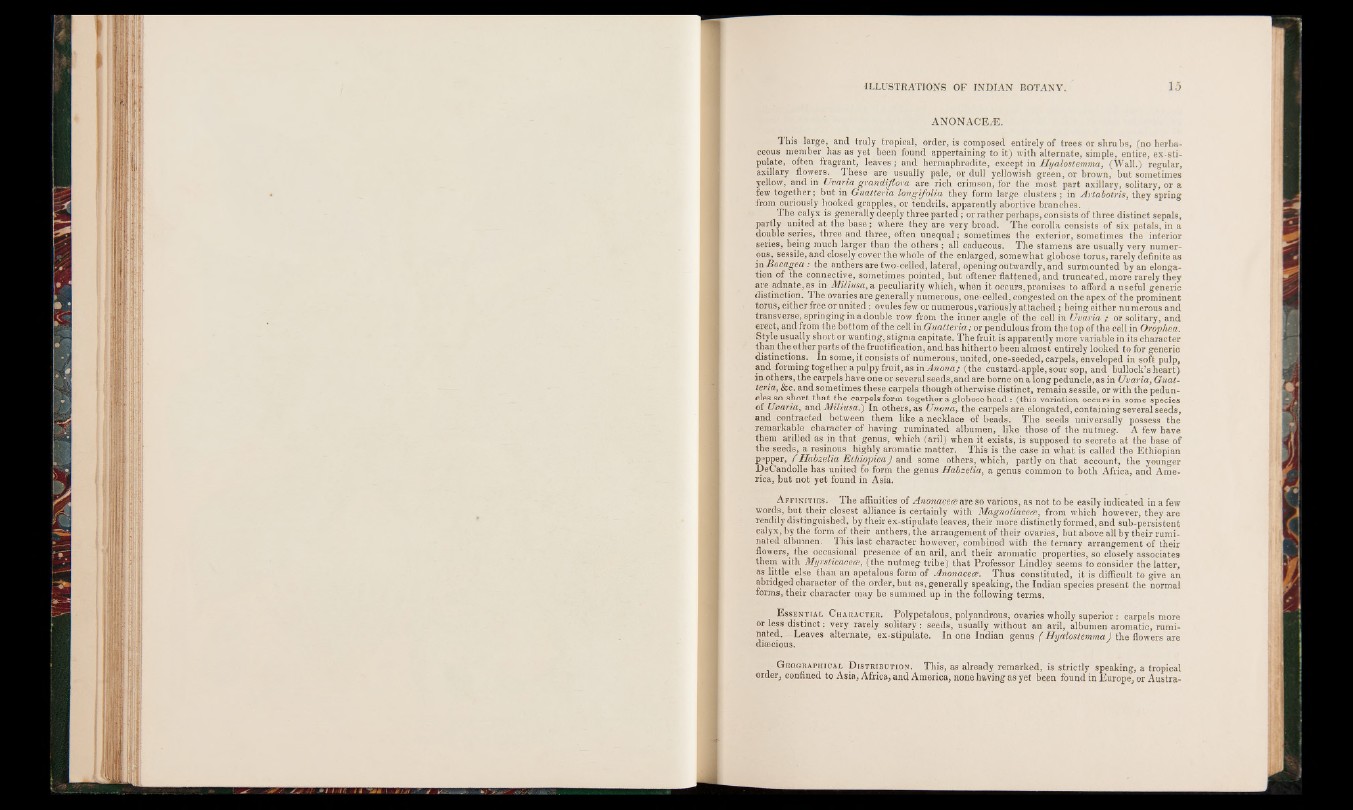
ANONACE M.
This large, and truly tropical, order, is composed entirely of trees or shrubs, (no herbaceous
member has as yet been found appertaining to it) with alternate, simple, entire, ex-stipulate,
often fragrant, leaves; and hermaphrodite, except in Hyalostemma, (Wall.) regular,
axillary flowers. These are usually pale, or dull yellowish green, or brown, but sometimes
yellow, and in Uvaria grandiflora are rich crimson, for the most part axillary, solitary, or a
few together; but in Guatteria longifolia they form large clusters; in Artabotris, they spring
from curiously hooked grapples, or tendrils, apparently abortive branches.
The calyx is generally deeply three parted ; or rather perhaps, consists of three distinct sepals,
partly united at the base; where they are very broad. The corolla consists of six petals, in a
double series, three and three, often unequal ; sometimes the exterior, sometimes the interior
series, being much larger than the others ; all caducous. The stamens are usually very numerous,
sessile, and closely cover the whole of the enlarged, somewhat globose torus, rarely definite as
in Bocagea : the anthers are two-celled, lateral, opening outwardly, and surmounted by an elongation
of the connective, sometimes pointed, but oftener flattened, and truncated, more rarely they
are adnate, as in Miliusa,a, peculiarity which, when it occurs, promises to afford a useful generic
distinction. The ovaries are generally numerous, one-celled, congested on the apex of the prominent
torus, either free or united : ovules few or numerous,variously attached; being either numerous and
transverse, springing in a double row from the inner angle of the cell in Uvaria ; or solitary, and
erect, and from the bottom of the cell inGuatteria; or pendulous from the top of the cell in Orophea.
Style usually short or wanting, stigma capitate. The fruit is apparently more variable in its character
than the other parts of the fructification, and has hitherto been almost entirely looked to for generic
distinctions. In some, it consists of numerous, united, one-seeded, carpels, enveloped in soft pulp,
and forming together a pulpy fruit, as in Anona; (the custard-apple, sour sop, and bullock’s heart)
in others, the carpels have one or several seeds,and are borne on along peduncle,as in Uvaria, GuaU
teria, &c. and sometimes these carpels though otherwise distinct, remain sessile, or with the peduncles
so short that the carpels form together a globose head: (this variation occurs in some species
of Uvaria, and Miliusa.') In others, as Unena, the carpels are elongated, containing several seeds,
and contracted between them like a necklace of beads. The seeds universally possess the
remarkable character of having ruminated albumen, like those of the nutmeg. A few have
them arilled as in that genus, which (aril) when it exists, is supposed to secrete at the base of
the seeds, a resinous highly aromatic matter. This is the case in what is called the Ethiopian
pepper, f Habzelia Elhiopica) and some others, which, partly on that account, the younger
DeCandolle has united fo form the genus Habzelia, a genus common to both Africa, and America,
but not yet found in Asia.
A f f in it ie s, The affinities of Anonacece are so various, as not to be easily indicated in a few
words, but their closest alliance is certainly with Magnoliacece, from which however, they are
readily distinguished, by their ex-stipulate leaves, their more distinctly formed, and sub-persistent
calyx, by the form of their anthers, the arrangement of their ovaries, but above all by their ruminated
albumen. This last character however, combined with the ternary arrangement of their
flowers, the occasional presence of an aril, and their aromatic properties, so closely associates
them with Myrsticacece, (the nutmeg tribe) that Professor Lindley seems to consider the latter,
as little else than an apetalous form of Anonacece. Thus constituted, it is difficult to give an
abridged character of the order, but as, generally speaking, the Indian species present the normal
forms, their character may be summed up in the following terms.
E ssential C haracter. Polypetalous, polyandrous, ovaries wholly superior : carpels more
or less distinct: very rarely solitary: seeds, usually without an aril, albumen aromatic, ruminated.
Leaves alternate, ex-stipulate. In one Indian genus ( Hyalostemma ) the flowers are
disecious.
G eographical D istribution. This, as already remarked, is strictly speaking, a tropical
order, confined to Asia, Africa, and America, none having as yet been found in Europe, or Austra